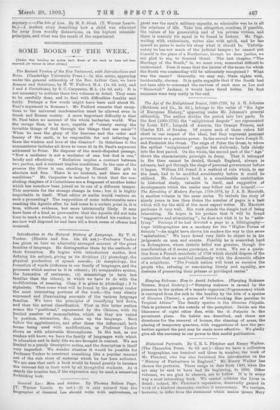Introduction to the Natural History of .Danguage. By T. G.
Tucker. (Blackie and Son. 10s. 6d. net.)—Professor Tucker has given us hero an admirably arranged account of the great families of language. He distinguishes them by the methods of their formation. Ile begins with introductory matter, first defining his subject, giving as its divisions (1) phonology, the physical production of speech sounds ; (2) morphology, the formation of words (inflexion in our family of languages, and the processes which answer to it in others) ; (8) comparative syntax, the formation of sentences ; (4) eeinasiology (a term less familiar than the others), in which we have to do with the modifications of meaning. Chap. 2 is given to phonology ; 3 to alphabets. Then come whet will be found by the geeeral reader the most interesting portions of the work,—tlae very clearly expressed and illuminating accounts of the various language families. We have the principles of classifying laid down, and then the actual classification. First in this latter section comes the "positional," represented by the Chinese, with its limited number of monosyllables, which as they are varied by position, intonation, &c., make up the lauguage. Next follow the agglutinative, and after these the infiexipnal, both terms being used with modifications, as Prefessqr Tucker Shows us with admirable thoroughness. In the last, as our readers will know, we have the family a languages with which In education and in daily life we are brought in contact. We are limited to a purely descriptive notice, and the deseription is itself very imperfect. We wonder whether it would be possible for Professor Tucker to construct something like a popular manual out of the rich store of material which be has bore collected. We are sure that such a book would be found greatly to increase the interest felt in their work by all thoughtful students. As it stands the treatise has, if the expression may be used, a somewhat forbidding look.










































 Previous page
Previous page